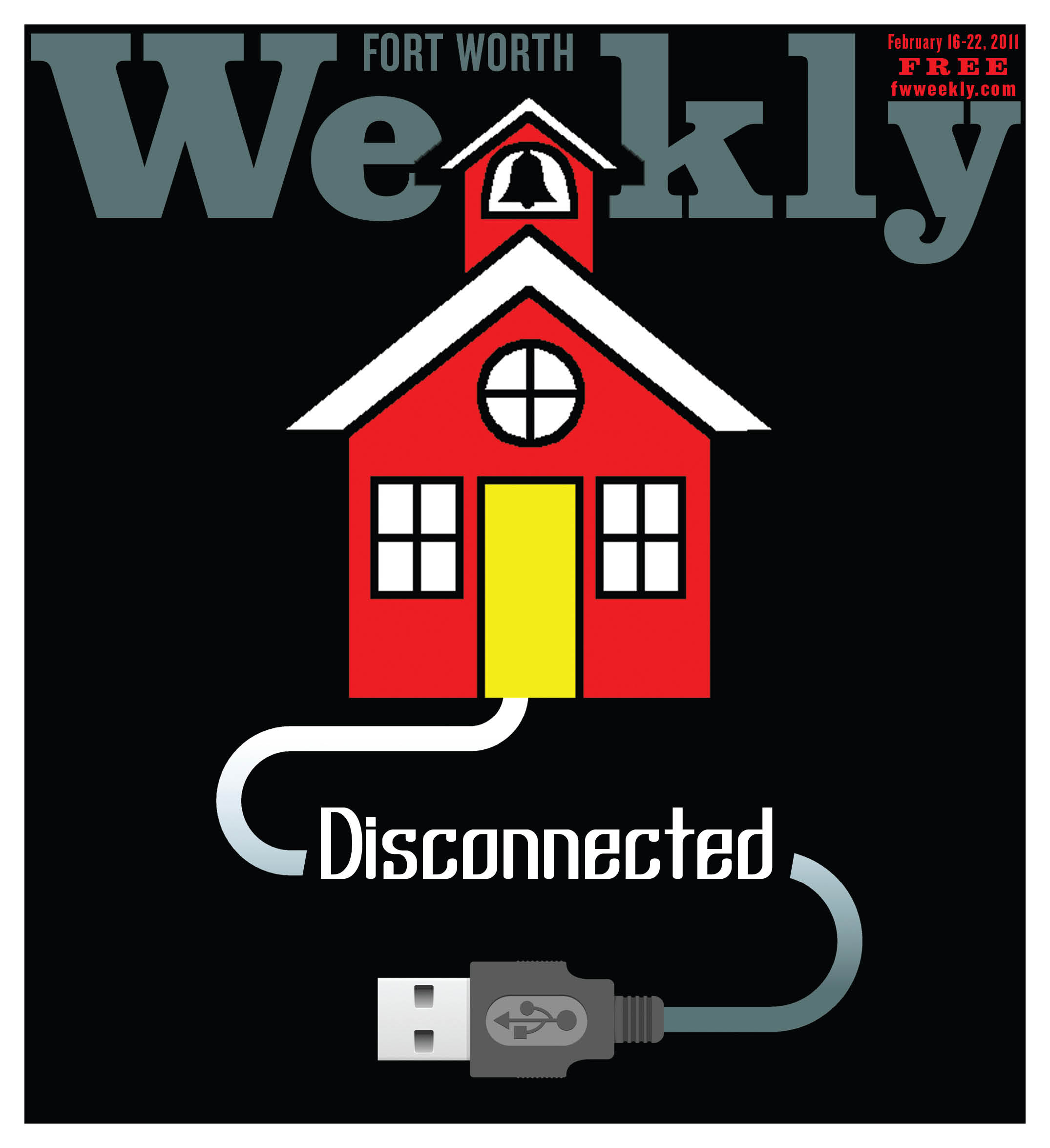This is the time of year when high school seniors usually receive the fall semester transcripts they need to apply for college. It’s also the time when they must start filing requests for the scholarships and other financial aid that are critical to so many students in this era of fast-rising tuition bills.
However, for a growing number of seniors in Fort Worth public schools, the process of getting into college has been put into jeopardy by a new student information software program so full of glitches that it has miscounted seniors’ credits and skewed class rankings, routinely loses information on crucial items like attendance and grades, and has even gotten some students’ parents’ names wrong.
 The program, called Connects, is a $5.6 million product of Tyler Technologies — the same Dallas-based company whose payroll software created havoc for the district in 2009 by overpaying employees and ex-employees more than $1.5 million before kinks were worked out.
The program, called Connects, is a $5.6 million product of Tyler Technologies — the same Dallas-based company whose payroll software created havoc for the district in 2009 by overpaying employees and ex-employees more than $1.5 million before kinks were worked out.
The student records software is forcing teachers and data clerks to spend endless extra hours entering and re-entering data that disappears or is inexplicably changed or otherwise bollixed. Many local high school students spent the first several weeks of the fall semester sitting in their schools’ libraries waiting for the system to figure out what classes they were in, because it had them enrolled in classes they didn’t need and dropped them from the ones they had signed up for. Teachers and clerks said the program, which operates off a single school-district computer server, is down almost half the time and works sluggishly for much of the time when it is operational.
Many seniors’ transcripts are now “totally inaccurate,” said one employee. “The problem is, we just don’t know how many are wrong.”
Beyond the endless headaches and extra hours of work the program is causing for teachers, data clerks, students, and parents, the software problems could have serious financial implications for the district, because the glitches are wreaking havoc with attendance records — and attendance is the basis on which the state figures out how many millions of dollars to contribute to the district’s operation. That’s particularly troublesome to a district that has already seen a major attendance fraud scandal this school year.
“We call it ‘dis-Connects,” a frustrated teacher told Fort Worth Weekly. Another said, “It seems to have been written by a software engineer who made a C in class. Surely there is some kind of software out there that is better.”
Kyle Davie, chief of technology for the district, calls the program a groundbreaking initiative that will bring tremendous rewards in the long run. In speaking with the Weekly, he first described glitches “in the first few weeks” and said the program had had a rough start here. He described extensive measures that the district and Tyler Technologies are taking to try to fix the problems, but eventually acknowledged that if the problems cannot be corrected, he will be the first to recommend scrapping the program.
“I am not married to Connects,” he said.
 Users of the system said that, six months into the school year, they’ve seen little improvement, and frustration levels are rising. At least four other school districts in Texas have already ditched the Tyler Technologies student records software.
Users of the system said that, six months into the school year, they’ve seen little improvement, and frustration levels are rising. At least four other school districts in Texas have already ditched the Tyler Technologies student records software.
Some Fort Worth school board members see the Connects problems as yet another black mark against the administration of Superintendent Melody Johnson, although she continues to be supported by a majority of the trustees.
“Trustees and the public are entitled to assurances [from Johnson] that the price tag of this system was worth it,” trustee Ann Sutherland said. “I hope we don’t make any more payments on Connects until the board considers the issue of keeping it. I am still hearing major complaints.”
Even Johnson’s critics say that Connects sounds good in theory. It is designed to integrate each student’s grades, attendance records, personal information, curriculum, and scheduling into one easy-to-access database. Ideally, it is supposed to provide an easier way for teachers, counselors, and data clerks to enter all of the information on each student required by law and, most importantly, to have accurate data to feed to the state and federal education agencies whence the district’s academic rankings and much of its operating monies flow.
One teacher said he took a training course offered by the district last June and initially thought the new program looked great. The glitches became obvious, he said, after school started in August. When he complained, he said he was told “to keep on doing it manually.” Plus, he said, the system is up only about 60 percent of the time.
“There are actually better programs out there,” said one longtime school district employee. “Once again the district shot themselves and us in the foot.” He is computer-savvy, he said, but even he cannot make the program work most of the time.
One of those “better programs,” from the point of view of many of those who must wrestle with the Connects software daily, is the program the school district was using before — a system known as School Administration Student Information with a component for grading called InteGrade. They think Connects was an expensive attempt to fix something that wasn’t broken.
“The InteGrade program … was simple,” one teacher wrote. She, like every nonadministrative Fort Worth school district employee interviewed for this story, asked that her name not
be used.
“Open the grade book, enter the student averages for a given subject, enter a number for a corresponding comment to appear on the report card, and in seconds, you’re done,” she said. “With the ‘dis-Connects’ program, forget about it. … It is an endless quagmire of redirecting back and forth from one portal to another with the dreaded uncertainty as to whether or not the system will save the line info that you have spent hours trying to input. … Teachers are spending more than double the amount of time as before, laboriously entering grades.”
Another teacher agreed that InteGrade worked quickly, using just one screen. Teachers could upload all the data on their own computers, save the data on a flash drive, and walk it over to the clerks who could quickly upload it into the system. As one teacher wrote, “Bada-bing, bada-boom, you’re done.”
School district spokeswoman Barbara Griffith said the district was forced to find a new student records software for the same reason that it switched to Tyler’s problem-filled payroll software: The old program was no longer going to be supported by its manufacturer.
Connects is part of a package of software the district leased from Tyler in the fall of 2007 for a total of $6.3 million. Included were the student records program, the payroll software, and a purchasing program. Note the word “leased.” The three-year contract states that Tyler owns and operates the software; the district buys access with the $6.3 million, which does not include user and maintenance fees. The cost is being paid in three installments over a three-year period, with about two-thirds of the original sum paid. For Connects, in addition to the original $4.9 million cost, the district is paying about $750,000 in user and maintenance fees for the duration of the contract.
The Weekly requested information several weeks ago on other bidders for the software contract. The district is required by law to provide such information within 10 working days, barring complications, but by press time, the data had not been provided nor had the district provided an explanation for its failure to turn it over.
Teachers and other employees say that they have been telling the administration for months that the program is so problematic that they are having to keep records the old-fashioned-way, with pencil and paper.
 Data clerks report they are working 12- to 14-hour days to correct the information in the system and that an entry that would have taken 10 seconds using the old software now can take from 30 minutes to several hours. The clerks take teachers’ daily records regarding attendance and grades and enter them into the district’s database in order to have an accurate record for the Texas Education Agency. Using the Connects system for this, one clerk said, is “a living nightmare.”
Data clerks report they are working 12- to 14-hour days to correct the information in the system and that an entry that would have taken 10 seconds using the old software now can take from 30 minutes to several hours. The clerks take teachers’ daily records regarding attendance and grades and enter them into the district’s database in order to have an accurate record for the Texas Education Agency. Using the Connects system for this, one clerk said, is “a living nightmare.”
“We are not just exhausted and getting sick,” she said, “we are costing the district a lot of money in overtime.”
A small but critical example of wasted time: The old program allowed clerks to enter a piece of information — say a student’s phone number — once and have the program copy it to all the appropriate places. But Connects files, a clerk said, are like Excel spreadsheets that “do not talk to each other,” so that phone number may need to be entered multiple times.
“We had teachers at my school who were trying to enter grades in the wee hours of the [morning] trying to meet a deadline, because … the system had lost the info they had entered the night before, and they had to start all over again,” one teacher said. The weekend before that, she said, when six-week grades were due, teachers received an e-mail from the administration telling them the system was locked down and grades could not be entered. What eventually happened, she said, was that all of the district’s more than 5,600 teachers were scrambling to enter their grades at the same time over one weekend, causing the system to be as “slow as a turtle with two broken legs.”
Trustee Sutherland said teachers, counselors, and data clerks in her district have poured out a long list of problems to her, including those of the lost data, multiple screens, and lengthy time consumed. Training on how to use the program was delivered via a PowerPoint presentation rather than hands-on, they told her.
In the fall, when so many students were finding multiple errors in the classes they had been assigned, counselors said, many seniors were dropped from hard-to-get-into honors classes only to find them full when the system finally tried to place them back in those courses.
Such students spent the first weeks of the fall semester sitting and waiting. “That took weeks to correct,” Sutherland said. The seniors were eventually put in the right honors classes after parents complained, but by then they had missed substantial amounts of work. After that, she said, “There were errors in the semester report cards,” in both grades and attendance.
Now, as the deadlines for college entrance and financial aid applications approach, seniors need transcripts that include four years of courses passed, grades earned, and class rankings. The transcripts should also show if the students transferred from other schools or dropped classes — but they don’t, one data clerk said.
Data-entry clerks, counselors, and teachers report that students are coming to them with angry complaints that their transcripts do not show credits for classes that they had taken and passed. Parents are showing up daily, one said, angry that their children’s attendance records are inaccurate on their report cards.
Many seniors are finding that their transcripts include multiple errors, one employee said. The transcripts simply “cannot be relied on — we know that.”
Additional problems are cropping up in the students’ personal records. Several student transcripts show totally incorrect names for parents or guardians — not just misspellings, but names the students have never heard of. “No one can explain how that is happening,” one clerk said.
In other cases, students’ Social Security numbers have disappeared from the system. “This program doesn’t recognize a Social Security number or the state I.D. given to undocumented kids as a ‘necessary’ number,” one data clerk said, “so it just drops that information from the system.”
Tony Katsulos, a spokesman for Tyler, wrote in an e-mail that the Connects software issues random student numbers instead of using Social Security numbers, for privacy reasons.
“Unfortunately, in Texas we are required to use Social Security numbers,” the clerk quoted above said, “and Tyler doesn’t take that into account. We made them aware of this problem as early as last May, but they have made no accommodation for us.”
She said that when the old system was switched to Connects, the Social Security numbers should have been transferred, but many were not. “If we submitted data to TEA without this number it would be unacceptable,” she said.
Other than the comment from Katsulos above, Tyler executives and technical staff declined to be interviewed for this story. Katsulos issued a boilerplate response by e-mail that said the company believed in the program and was working closely with the district to resolve any problems.
Another of those problems: The system drops students from class rolls with no record of who was dropped, “Names just disappear,” one teacher wrote. The program also adds students to class rolls without the teachers’ knowledge.
“Names of students appear out of nowhere, when they are not even in the class,” one wrote.
“Connects seems to have a mind of its own,” said another.
First-semester report cards came out last week, days late and “full of errors,” one employee told the Weekly. Errors were especially bad in the attendance records, she said, calling it a “big mess.”
Students who started in one class but were moved to another class period in order to balance class enrollments had inaccurate absences marked against them, causing the students to lose credit.
 Tammy, who asked that she be identified only by her first name to protect her child’s identity, told the Weekly that she is “very angry” because her Western Hills High School freshman son’s report card was at least a week late and his attendance records were “totally inaccurate,” including showing him as frequently tardy when “he was never tardy.
Tammy, who asked that she be identified only by her first name to protect her child’s identity, told the Weekly that she is “very angry” because her Western Hills High School freshman son’s report card was at least a week late and his attendance records were “totally inaccurate,” including showing him as frequently tardy when “he was never tardy.
“I heard from many other parents that inaccurate tardy and absence data turned up on everybody’s kids’ report cards,” she said. “My son is in accelerated classes, and he is never late or absent.”
The Connects program also drops grade information after teachers have entered it.
Larry Shaw, head of the United Educators Association, the largest educators’ union in the county, said teachers from across the district are coming to him in frustration and panic.
“They tell me that they would spend half the night putting their students’ grades into the system only to find them gone by morning,” he said. “They had just disappeared, and the work had to be done all over again. When you are an English teacher with 180 students, you’ve got a problem.”
The other issue that is causing angst is attendance. “Everyone’s worried about the attendance data,” Shaw said, because the district’s state funding is based on its average daily attendance figures. “Teachers are asked to sign their daily attendance documents to verify their accuracy,” he said, but the Connects system inserts endless errors regarding which students were absent or present and which absences were excused or unexcused.
“Now teachers are fearful that if they sign off on these figures that turn out to be inaccurate, they could be charged with attendance fraud by the state,” Shaw said.
Early on, Johnson gave high praise to the Connects feature called the “parent portal.” It’s supposed to provide a link for parents to find out how their kids are doing academically, if they are in class, what they are supposed to be studying, and where they are supposed to be on any given day. When the idea first came up, Griffith told the Weekly that it would be in use by the beginning of the 2010-2011 school year.
However, Davie is not using the Tyler program’s parent portal, he said. He dropped it and had his team design their own, one that will interact with Connects, he said, “but is more user-friendly for parents.”
Sutherland got a bit of a different take. She said Davie told her he had to write his own version because the Connects parent portal just “did not work.”
But even Davie’s newly designed parent portal is not up systemwide, he said. “We have it in six schools as a pilot program right now.”
Other districts have had similar problems with the link for parents. That was one of the reasons that Georgetown schools gave for dropping the Tyler program.
Davie, however, said he still believes the Connects program will bring major benefits in efficient data-gathering in the future — when all the kinks are
worked out.
In a recent e-mail to the Weekly regarding the latest complaints, Davie wrote, “We have not found a significant number of issues with either the report cards or the denial of credit process that runs after each semester.” He also suggested that parents and others don’t understand how the attendance information is shown on report cards — absences are tallied both by current classes the student is in and cumulatively for the year.
When told of Davie’s response, one frustrated data clerk replied that she and her colleagues as well as counselors and teachers from her school have made administrators aware of all of the problems “to no avail.”
As for his explanation of the attendance discrepancies, she said, “This is just not true. We have not been able to find a pattern to the absences shown on the report cards, and believe me, we have tried. In any event, his assertion that both are correct is absurd.”
Davie acknowledged that it has been “a challenging year” for the Connects program, with “glitches in the first few weeks.” Two weeks ago he said Tyler technicians were in the district that day trying to find the bugs and fix them. But district employees say the situation has not improved — one noted that Tyler technicians are now in the district “daily.”
In order to address the employees’ concerns, Davie said a help hotline has been established. The ad-hoc committee of employees set up to monitor the program last August has been expanded from six to 19 members, with data clerks added to the group. To date, it has met only once, but one new member said he was impressed with the group’s makeup and believes it will do an honest evaluation of the system.
Griffith said that Johnson wants feedback from those on the ground trying to make the system work. But she also said that resistance to the program by older teachers who are not comfortable with computers has been a major hurdle.
The new program is a “sea change” in technology for the district’s employees, she said. “We are talking about a huge cultural change, bringing in all of these new programs,” Griffith said. “We went from Stone Age to 21st-century technology overnight.” A former journalist, Griffith compared what is happening in the Connects program to the resistance in newsrooms decades ago by older journalists loath to switch from their manual typewriters to computers.
 It is hardly a fair comparison, said Shaw. “We hired teachers to teach, not to be computer experts,” he said. “At some point the district has got to admit that it is the program that is flawed, not the people who are trying to use it,” he said.
It is hardly a fair comparison, said Shaw. “We hired teachers to teach, not to be computer experts,” he said. “At some point the district has got to admit that it is the program that is flawed, not the people who are trying to use it,” he said.
Sutherland is one trustee who may vote for “something better” if Connects continues to cause problems. “I am willing to give it some more time,” she said, “but not much.” The reason for that is Sutherland’s trust of Davie.
He was hired from the Providence, R.I., school district where Johnson was superintendent before she came here. The Connects program was in place when he arrived. Sutherland said she trusts him to recommend dumping the program if it cannot be made to work.
Shaw believes the board is running out of time to make a decision. “The board needs to demand that the district haul Tyler’s people back in and tell them to fix the problems, make it work, or have the district lawyers start looking for ways to break the contract, since it did not perform as promised,” he said. He believes there is a case to be made that Tyler, not the district, has violated the contract.
A copy of the contract signed by Johnson that the Weekly received under an open-records request states that the contract can be terminated for cause if Tyler fails to perform as promised. The company would have 30 days to “cure” the problems, and if it could not, the district has the right to terminate the contract without penalty. (The district would still have to pay for any “goods and services” not in dispute.)
Even if the district scraps Connects for something better, it could be a year before a new system is in place — certainly not in time to help this year’s seniors.
Several Texas districts have already scrapped it, including Georgetown, Brenham, Azle, and Willis. All cancelled their contracts with Tyler after months of unsuccessfully trying to make the program work.
The Georgetown school board made that decision recently because of the software’s multiple failures to perform what was promised. One of those failures involved the parent portal.
“They were never able to get that implemented,” said Brad Domitrovich, director of school and community relations. Georgetown, which has only 17 schools and a little more than 10,000 students compared to Fort Worth’s 144 schools and 80,000 students, is currently in negotiations with the company over a settlement of the contract.
Last March, Brenham and Azle both replaced Tyler’s program with software from their TEA Regional Service Center.
An article from June 2010 in the Conroe Courier described problems in the Willis school district, north of Houston. According to the news report, the school board at that time was discussing the “dismal failure” of the Tyler student information system and the need to replace it. The problems listed sound familiar: “an inability to account for all students enrolled, an inability to provide accurate grade point averages, and an inability to provide timely report cards or transcripts for all seniors.”
Shaw’s group conducted on-line blind surveys on the Connects program in August and January. Both times, more than 600 employees responded, each time with close to 70 percent of the respondents reporting strong dissatisfaction with the program.
“We warned the district that this system wasn’t ready and was a disaster waiting to happen,” one clerk said, “and now it is happening.” She said that if it was not for the students, she would be willing to let the system fail rather than try to make it work. “The sooner it fails completely, the sooner the district will do something,” she said. But, she added, “If that happens, the kids will pay the price, and I care too much for these students to let that happen.”
Her concerns for the students’ welfare were echoed by all of the teachers interviewed.
Many critics believe the whole Connects program should have been tried as a pilot project first.
“We [UEA] asked them to implement the program in pilots in a few schools around the district to see where the glitches were and fix them before they put it out systemwide,” Shaw said. But the administration “was determined to implement it across the district.”
Northside trustee Carlos Vasquez sees the Connects problem as one more management failure on the part of Johnson. He pointed out that two years after the problems with the Tyler Technologies’ payroll program were uncovered, he is still hearing from employees whose paychecks are messed up. Several of the employees interviewed by the Weekly also saw the Connects problems as just the latest in a long line of administrative screw-ups in
the district.
Vasquez has become one of Johnson’s most consistent critics and recently called on the board to fire her. Two of his board colleagues — Sutherland, who represents southwest Fort Worth, and Juan Rangel of the Near South Side — are also unhappy with the way she is managing the district. However, Johnson still has the support of the other six members.
The list of complaints by district workers against Connects goes beyond what it does badly. A couple of things that the old system provided, Connects doesn’t offer at all. It has no place for student pictures, for instance — something teachers said is a critical tool in a district as large as Fort Worth, with many students who transfer in or out in the middle of the school year, drop classes, add classes, or are chronically truant.
And one of the oldest and most familiar grading boxes on a student’s report card has been completely dropped. Kids in Fort Worth public schools, it seems, can now act out in class or talk back to their teacher without fear. They are no longer being graded for “citizenship” because Connects doesn’t recognize the concept.












[…] https://www.fwweekly.com/2011/02/16/dis-connects/ […]